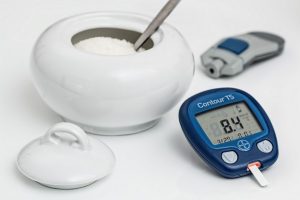
Maybe you or a loved one was just diagnosed with type two diabetes (T2D). Or perhaps you’ve been struggling with it for years. Either way, it’s hard to be diagnosed with a chronic condition.
It changes your psychological landscape, and keeping the condition under control seems impossible. Truthfully, insulin resistance is reversible and manageable through simple changes that can also prevent complications.
Quick Basics
T2D is a lifelong condition where cell receptors become resistant to insulin even though the pancreas continues to produce it. Pancreatic beta cells release insulin to allow other cells in your body to collect, convert, and store energy.
The cells in the liver and muscles have a layer of mitochondria that exposes itself through insulin absorption, and it turns carbohydrates into glucose.
With too many carbs, the cells become overworked, but the pancreas continues to produce insulin. Eventually, the mitochondria stop functioning as they should.
Tracking Your Blood Glucose Levels
Insulin resistance can worsen if it’s unmonitored. Make sure you have a blood glucose meter with lancets and test strips to keep an eye on your glucose levels when you wake up, before meals, an hour after meals, and at bedtime.
A normal fasting blood glucose reading is between 71 and 140 milligrams per deciliter (mg/dL). Anything lower is hypoglycemia, and anything higher is hyperglycemia, both of which are dangerous.
What Causes Fluctuations?
A few things can cause your blood glucose to spike, such as:
● Eating too many carbohydrates, especially the simple ones
● Eating very large meals
● Skipping your medication
● Not exercising
● Stress, pain, and other illnesses
● Sunburn
● Skipping breakfast
● A lack of sleep
● The dawn phenomenon (your blood glucose levels spike around 3:00 AM)
● Dehydration
● Menstrual cycles
● Steroids and antipsychotic medication side effects
Certain things also cause hypoglycemia, such as:
● Not eating enough or missing meals
● Reducing your carbohydrate intake too much
● Alcohol
● Taking too high of a dose of your diabetic medication
● Too much physical activity (exercise routines should always be discussed with your doctor)
● Side effects from other medications
● Hormone deficiencies
Quick Balancing Acts
Blood glucose that’s too high or low can cause serious complications, so you want to restore balance.
Some ways to bring blood glucose down fast are:
● Drink two glasses of water
● Exercise
● Drink green tea
● Drink black coffee
● Seek medical attention if levels remain high
What to do if your blood glucose is too low:

- Eat or drink something with fast-acting sugar, albeit a small amount
- Wait 10 minutes
- Test your glucose again
- Seek medical attention if your levels remain low
Two Main Homecare Reminders
Two changes in your daily life can help you maintain better control and even reverse the condition. Remission isn’t a cure; it’s the temporary reversal of a condition, and it’s up to you to keep it that way.
Maintaining Weight Loss
Weight loss is the best management strategy for T2D. Evidence suggests that it can cause remission in diabetic patients, but remission is temporary and controlled by your daily lifestyle, which means that you need to maintain the weight loss.
A longitudinal study of 33,184 participants over 23 years was published in the BMC Public Health Journal. The subjects were all at high risk of developing T2D, and the majority of their body mass indices (BMIs) were nearly normal at 25.
Over the years, those who didn’t maintain their BMI had an increase in their risk for diabetes. The risk increased by between 1.04 and 1.06% every time the participants gained one percent of their body weight.
Weight maintenance is associated with better management. The accumulation of fat around the liver and pancreas leads to your beta cells not working properly, which could cause insulin resistance or the eventual need for insulin.
A review by Newcastle University examined the likelihood of staying in remission with fast weight loss and maintenance. According to the review, many diabetics lose weight, but they quickly regain it over the first year.
This yo-yo effect doesn’t decrease the long-term risks of the condition returning. According to the Diabetes Remission Clinical Trial (DiRECT), maintenance should follow a loss of 33 pounds.
Using a low-calorie diet with physical activity helps you melt the fat around your liver and pancreas, but maintaining it requires you to stick to a healthier lifestyle and avoid returning to old habits.
Participants of numerous studies in the review were more successful in long-term remission when they maintained their weight loss. Some of them maintained remission for 5 and 10 years.
Don’t simply aim to lose weight; use diabetic-friendly lifestyle changes to keep your risk at bay.

Psychological Battle
Finding out that you have a lifelong condition takes its toll on your psychological wellbeing. Stress is natural when you don’t know how to manage your condition or reverse it. Unfortunately, the stress hormones cortisol and adrenaline aggravate T2D.
They cause uncontrollable fluctuations in blood glucose, impair glucose and insulin tolerance, and activate fat cells. Stress even pushes your blood pressure up, causing your risk for heart disease to increase.
The only way to avoid this is by dealing with your stress daily. Some useful methods to reduce stress include:
● Journaling
● Meditation
● Mindfulness
● Socializing
● Exercise
● Laughing more
● Learning more about diabetes
● Eating healthier
● Sleeping better
● Talking to a professional
● Removing stress triggers
● Practicing progressive muscle relaxation (PMR)
● Using breathing exercises
● Organizing your days
● Taking a nature walk
● Hugging someone
● Getting a new hobby
● Setting SMART goals
● Adopting optimism
● Practicing positive self-talk
● Expressing gratitude
● Joining a yoga class

Living under stress only makes the battle harder. Adopt a few new habits to counteract
the consequences of uncontrolled T2D.
Final Thoughts
Managing your T2D at home is simple with the right knowledge, weight loss to keep your condition under control, and stress-reducing techniques to make your days a little easier.
